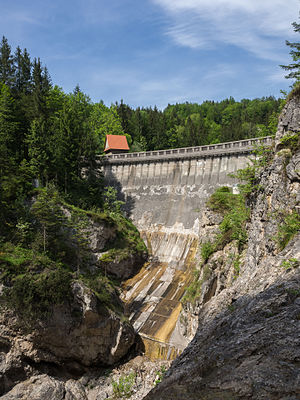Strubklamm power plant
| Strubklamm power station | |||
|---|---|---|---|
| Strubklamm power plant, dam wall | |||
| location | |||
|
|
|||
| Coordinates | 47 ° 45 '43 " N , 13 ° 11' 0" E | ||
| country |
|
||
| Waters | Almbach | ||
| Data | |||
| Primary energy | water | ||
| Start of operations | 1924 | ||
The Strubklamm power plant is a hydropower plant above and below the Strubklamm (natural monument) in the Faistenau municipality in the Salzburg-Umgebung district and in the Adnet municipality in the Hallein district , both in the state of Salzburg .
description
The power plant Strubklamm even Strubklamm power plant or Strubklamm work called, built in the years 1920 - 1924 , which forms upper stage of a two-stage work, which is the catchment area and the slope of Almbaches that Oberalm , an orographic right tributary of the Salzach exploits in vollkommenster way .
The lower level is the Wiestal power plant , built between 1909 and 1913 . After the Wiestal power plant with the Wiestal reservoir in the Wiestal could no longer supply sufficient power for the power supply of the city of Salzburg , further use of the water power of the Almbach began in 1920. At the upper end of the Strubklamm a dam was built for a reservoir (= Strubklamm reservoir) and the water was connected to the power house near the lower end of the Strubklamm via a pressure pipe. On October 8, 1921 , the tunnel to the power station was breached.
Between 1981 and 1984 , a new, modern power plant building was built by Salzburg AG in addition to the historic Strubklamm power plant and, in particular, a new headrace tunnel was built. This made it possible to use the water from the Hintersee directly. The output of the power plant has thus doubled (see Strubklamm storage power plant ). The former listed machine house was taken out of use and is now used as a warehouse.
history
The construction of the Strubklammwerk, the structural part of which was entrusted to the Pittel & Brausewetter company in Vienna for execution, while the turbines were supplied by JM Voith and the electrical equipment from the Austrian Siemens-Schuckert-Werke, began in November 1920 but was catastrophic devaluation and the constant deterioration of the economic situation could only be continued until Christmas 1921. After lengthy negotiations with various financial groups, a contract was finally concluded with Württembergische Elektrizitäts-AG (Weag) in Stuttgart , which secured the continuation of construction. Later, when Germany's valutary conditions were badly shaken, the taking out of two British loans in the amount of 220,000 pounds made it possible to complete the building, which stood at around 70 billion kroner .
The Strubklamm plant was 1923 / 1924 for completion by the Württembergische AG Electricity (WEAG).
The power plant was officially opened on December 20, 1924 in the presence of Federal President Michael Hainisch and Federal Chancellor Rudolf Ramek . However, due to unexpectedly poor soil conditions at the reservoir, a lot of water seeped away.
Technical specifications
At the Strubklammwerk, an 80 m long, 36.5 m high, bottom 30 m wide and under a radius of 75 m curved dam wall in rammed concrete, the water side of which appears to be sealed by the Torkret process, a storage basin with a usable volume of 2.5 million cubic meters created. As a relief device for the discharge of a catastrophic flood rate of 300 m³ / second, a flood overflow with two 20 m wide openings, each 20 m wide, which can be closed by roof weirs according to the Huber & Lutz system, was blown into the natural rock on the left side of the valley During the construction work, the 77 m long circulation tunnel is used, which can be closed by two iron gates.
The service water was directed on the left bank of the gorge through a 2,415 m long pressure tunnel with a clear cross section of 3.3 m², blasted into the main dolomite, down to the power house, located in Wimberg in the Wiestal .
At the end of this tunnel, which with a gradient of 1 per thousand, a maximum process water volume of 9.3 m³ / sec. The water lock with a volume of 2300 m³, consisting of a 16 m high and 6 m wide chamber, as well as a compensating shaft and overflow tunnel leading over the day , was located in the rock . The supply from the water tower to the power house was carried out by means of a circular pressure shaft located entirely in the main dolomite with cast-in (25 or 45 cm average thickness) iron pipes with wall thicknesses of 7 to 25 mm and a clear inner diameter of 1700 mm.
The machine house , currently referred to as a power house, is a listed building and is located in the district of Wimberg in the municipality of Adnet in the Hallein district in the state of Salzburg .
architecture
The former power house was built in 1923/1924 with a nearby, also listed, industrial estate as a terraced house under the construction management of Vice-Mayor Richard Hildmann , the architect of the facility was Erwin Blankenhorn.
The next bridge located at the mouth of Almbaches in Wiestalstausee than art in architecture hl a figure. Georg by Hans Pacher (1949).
Web links
swell
- ANNO , Die Wasserwirtschaft, 1925, issue 1, page 9
- Strubklamm storage power plant on SalzburgWIKI


